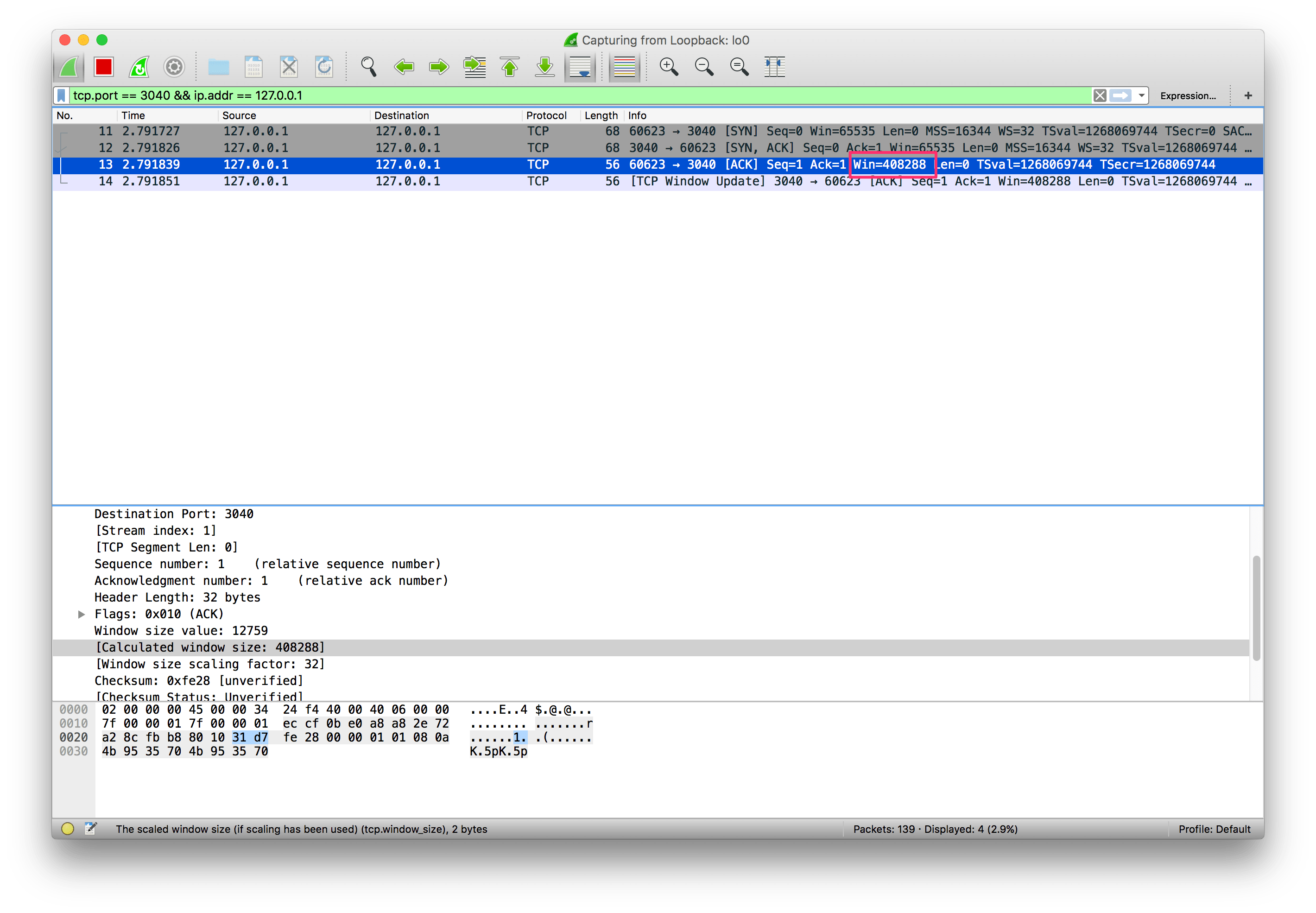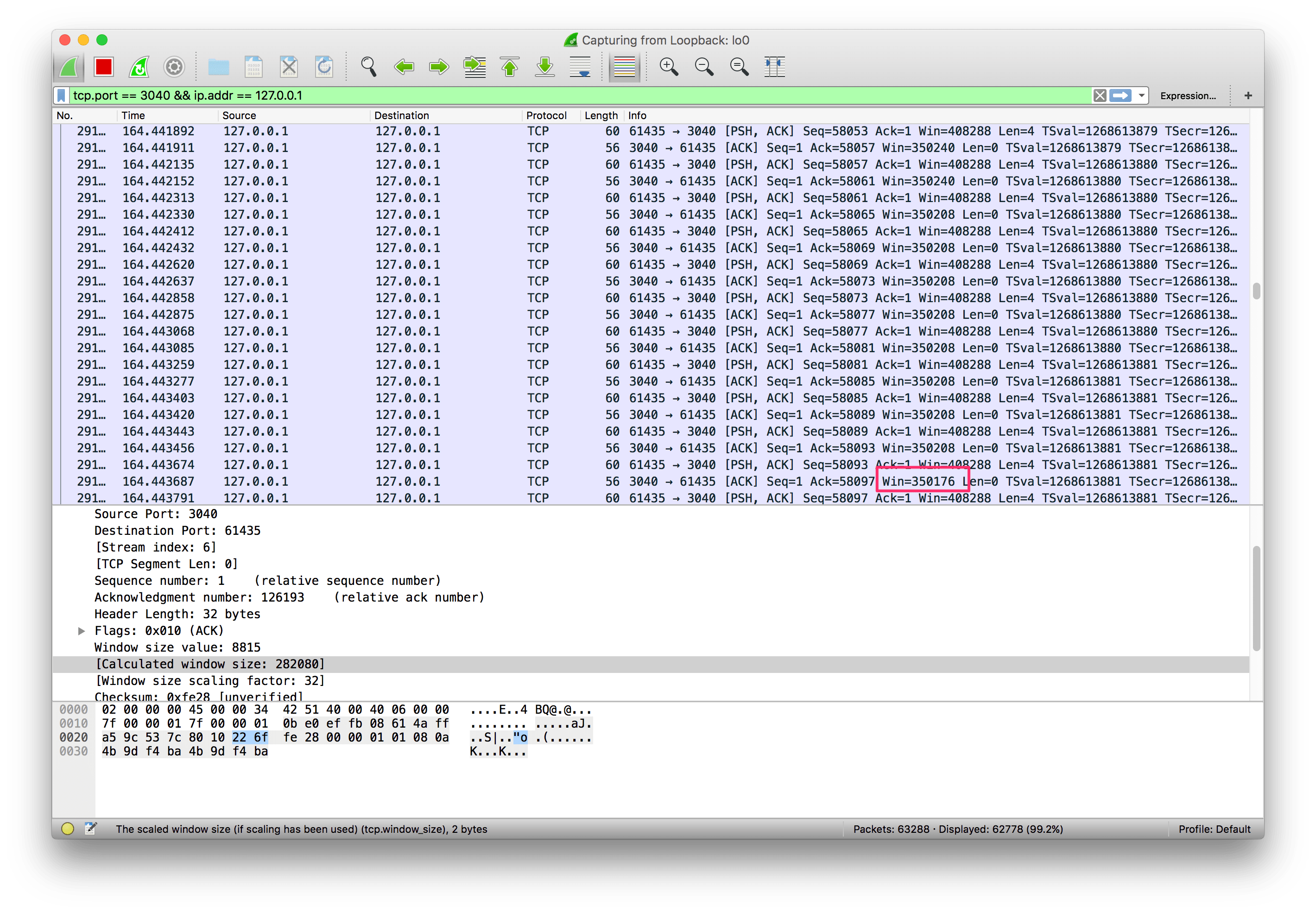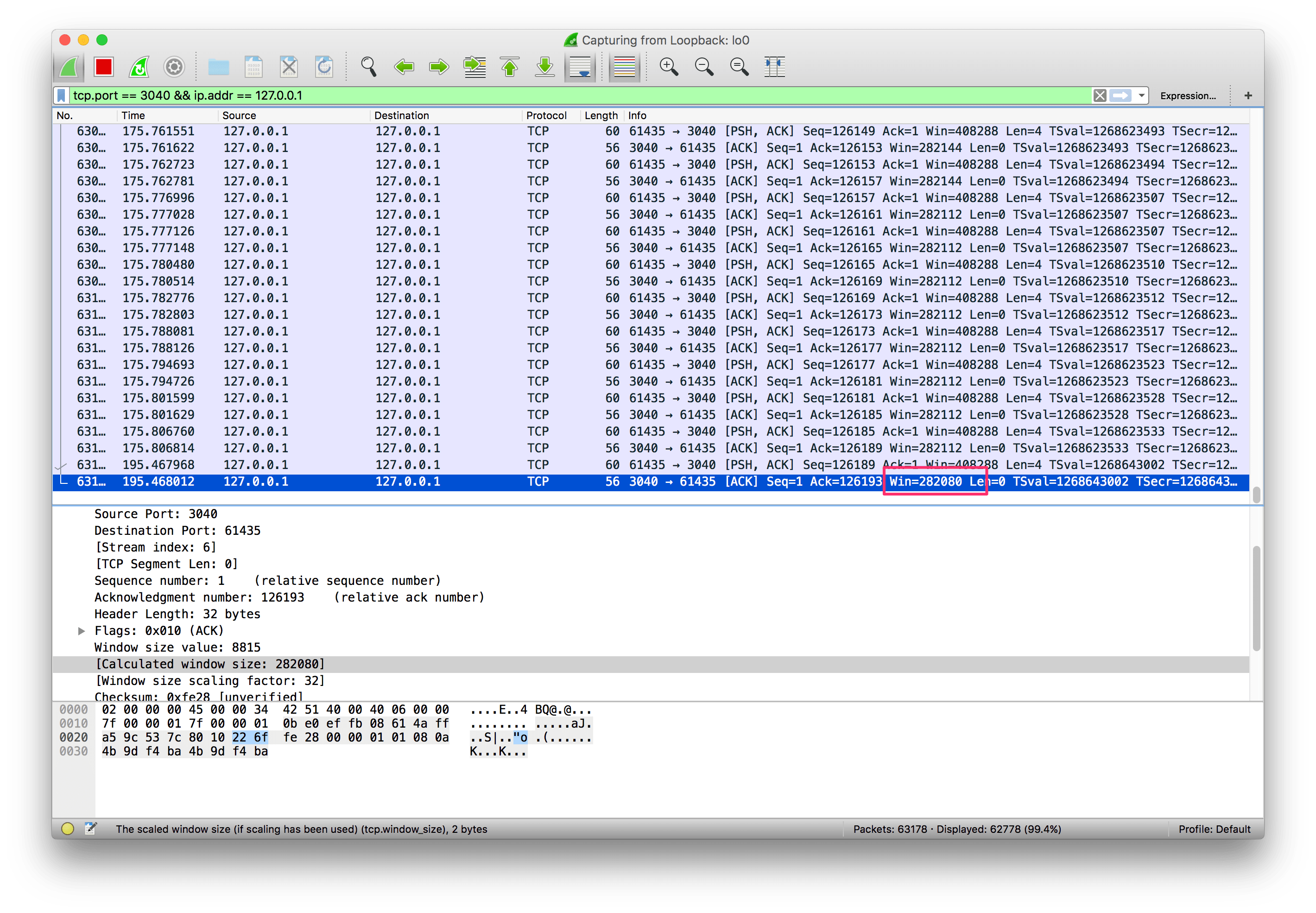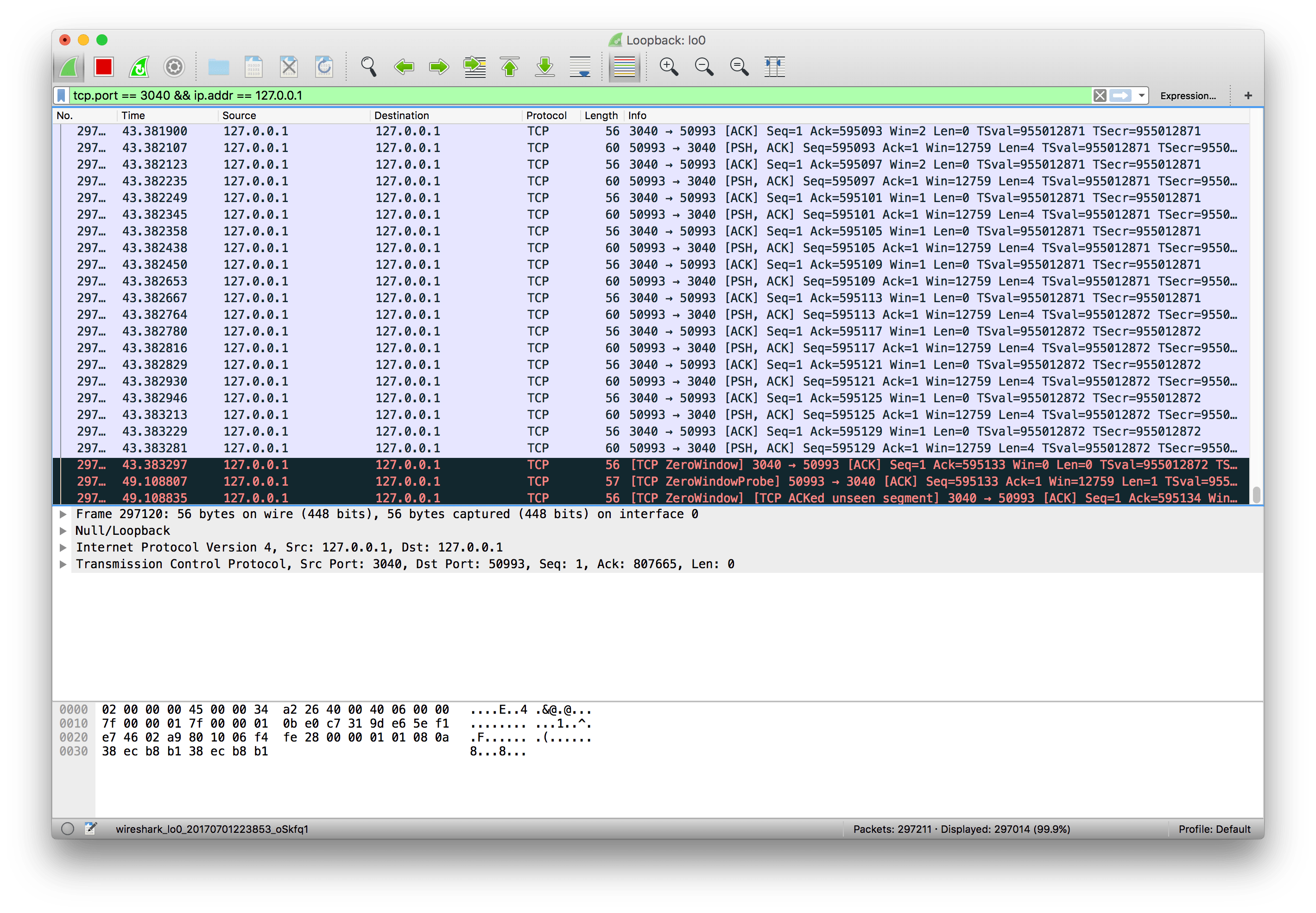TCP Flow Control
TCP is the protocol that guarantees we can have a reliable communication
channel over an unreliable network. When we send data from a node to another,
packets can be lost, they can arrive out of order, the network can be congested
or the receiver node can be overloaded. When we are writing an application,
though, we usually don’t need to deal with this complexity, we just write some
data to a socket and TCP makes sure the packets are delivered correctly to the
receiver node. Another important service that TCP provides is what is called
Flow Control. Let’s talk about what that means and how TCP does its magic.
What is Flow Control (and what it’s not)
Flow Control basically means that TCP will ensure that a sender is not
overwhelming a receiver by sending packets faster than it can consume. It’s
pretty similar to what’s normally called Back pressure in the Distributed
Systems literature. The idea is that a node receiving data will send some kind
of feedback to the node sending the data to let it know about its current
condition.
It’s important to understand that this is not the same as Congestion
Control. Although there’s some overlap between the mechanisms TCP uses to
provide both services, they are distinct features. Congestion control is about
preventing a node from overwhelming the network (i.e. the links between two
nodes), while Flow Control is about the end-node.
How it works
When we need to send data over a network, this is normally what happens.

The sender application writes data to a socket, the transport layer (in our
case, TCP) will wrap this data in a segment and hand it to the network layer
(e.g. IP), that will somehow route this packet to the receiving node.
On the other side of this communication, the network layer will deliver this
piece of data to TCP, that will make it available to the receiver application
as an exact copy of the data sent, meaning if will not deliver packets out of
order, and will wait for a retransmission in case it notices a gap in the byte
stream.
If we zoom in, we will see something like this.
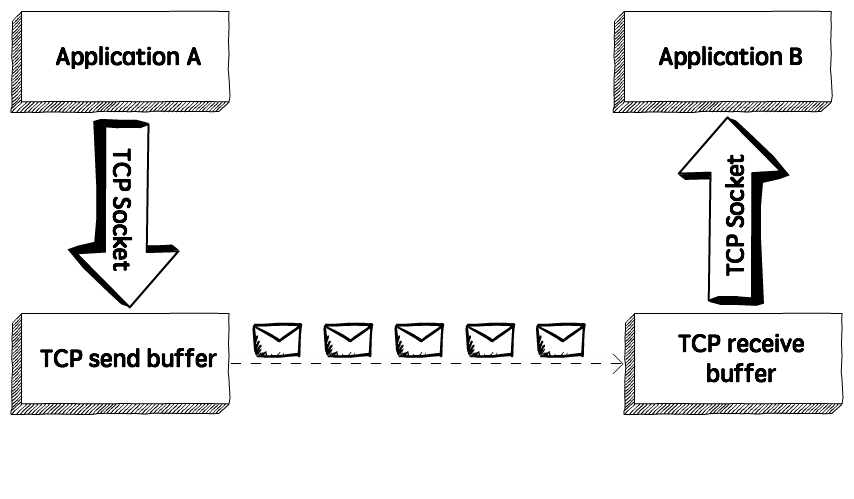
TCP stores the data it needs to send in the send buffer, and the data it
receives in the receive buffer. When the application is ready, it will then
read data from the receive buffer.
Flow Control is all about making sure we don’t send more packets when the receive buffer is already full, as the receiver wouldn’t be able to handle them and would need to drop these packets.
To control the amount of data that TCP can send, the receiver will advertise
its Receive Window (rwnd), that is, the spare room in the receive buffer.
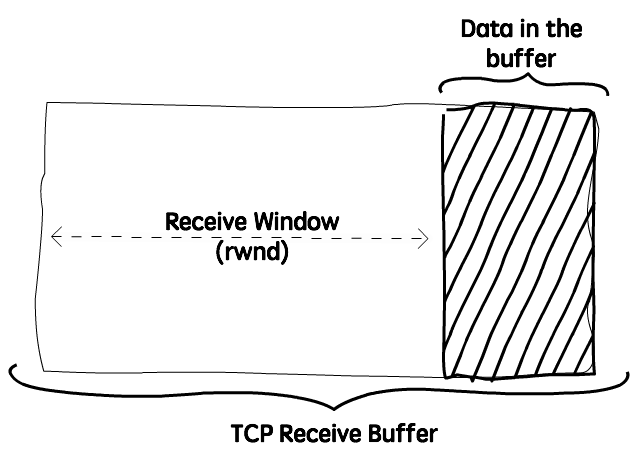
Every time TCP receives a packet, it needs to send an ack message to the
sender, acknowledging it received that packet correctly, and with this ack
message it sends the value of the current receive window, so the sender knows if
it can keep sending data.
The sliding window
TCP uses a sliding window protocol to control the number of bytes in flight it
can have. In other words, the number of bytes that were sent but not yet acked.
Let’s say we want to send a 150000 bytes file from node A to node B. TCP could
break this file down into 100 packets, 1500 bytes each. Now let’s say that when
the connection between node A and B is established, node B advertises a receive
window of 45000 bytes, because it really wants to help us with our math here.
Seeing that, TCP knows it can send the first 30 packets (1500 * 30 = 45000)
before it receives an acknowledgment. If it gets an ack message for the first
10 packets (meaning we now have only 20 packets in flight), and the receive
window present in these ack messages is still 45000, it can send the next 10
packets, bringing the number of packets in flight back to 30, that is the limit
defined by the receive window. In other words, at any given point in time it can
have 30 packets in flight, that were sent but not yet acked.

Now, if for some reason the application reading these packets in node B slows
down, TCP will still ack the packets that were correctly received, but as
these packets need to be stored in the receive buffer until the application
decides to read them, the receive window will be smaller, so even if TCP
receives the acknowledgment for the next 10 packets (meaning there are currently 20
packets, or 30000 bytes, in flight), but the receive window value received in
this ack is now 30000 (instead of 45000), it will not send more packets, as
the number of bytes in flight is already equal to the latest receive window
advertised.
The sender will always keep this invariant:
LastByteSent - LastByteAcked <= ReceiveWindowAdvertised
Visualizing the Receive Window
Just to see this behavior in action, let’s write a very simple application that
reads data from a socket and watch how the receive window behaves when we make
this application slower. We will use Wireshark to see these packets,
netcat to send data to this application, and a go program to read data from
the socket.
Here’s the simple go program that reads and prints the data received:
package main
import (
"bufio"
"fmt"
"net"
)
func main() {
listener, _ := net.Listen("tcp", "localhost:3040")
conn, _ := listener.Accept()
for {
message, _ := bufio.NewReader(conn).ReadBytes('\n')
fmt.Println(string(message))
}
}
This program will simply listen to connections on port 3040 and print the
string received.
We can then use netcat to send data to this application:
$ nc localhost 3040
And we can see, using Wireshark, that the connection was established and a
window size advertised:
Now let’s run this command to create a stream of data. It will simply add the string “foo” to a file, that we will use to send to this application:
$ while true; do echo "foo" > stream.txt; done
And now let’s send this data to the application:
tail -f stream.txt | nc localhost 3040
Now if we check Wireshark we will see a lot of packets being sent, and the
receive window being updated:
The application is still fast enough to keep up with the work, though. So let’s make it a bit slower to see what happens:
package main
import (
"bufio"
"fmt"
"net"
"time"
)
func main() {
listener, _ := net.Listen("tcp", "localhost:3040")
conn, _ := listener.Accept()
for {
message, _ := bufio.NewReader(conn).ReadBytes('\n')
fmt.Println(string(message))
+ time.Sleep(1 * time.Second)
}
}
Now we are sleeping for 1 second before we read data from the receive buffer. If
we run netcat again and observe Wireshark, it doesn’t take long until the
receive buffer is full and TCP starts advertising a 0 window size:
At this moment TCP will stop transmitting data, as the receiver’s buffer is
full.
The persist timer
There’s still one problem, though. After the receiver advertises a zero window,
if it doesn’t send any other ack message to the sender (or if the ack is
lost), it will never know when it can start sending data again. We will have a
deadlock situation, where the receiver is waiting for more data, and the sender
is waiting for a message saying it can start sending data again.
To solve this problem, when TCP receives a zero-window message it starts the
persist timer, that will periodically send a small packet to the receiver
(usually called WindowProbe), so it has a chance to advertise a nonzero window
size.
When there’s some spare space in the receiver’s buffer again it can advertise a non-zero window size and the transmission can continue.
Recap
TCP’s flow control is a mechanism to ensure the sender is not overwhelming the receiver with more data than it can handle;- With every
ackmessage the receiver advertises its current receive window; - The receive window is the spare space in the receive buffer, that is,
rwnd = ReceiveBuffer - (LastByteReceived – LastByteReadByApplication); TCPwill use a sliding window protocol to make sure it never has more bytes in flight than the window advertised by the receiver;- When the window size is 0,
TCPwill stop transmitting data and will start the persist timer; - It will then periodically send a small
WindowProbemessage to the receiver to check if it can start receiving data again; - When it receives a non-zero window size, it resumes the transmission.
If you want to learn more about TCP (and a lot more), the book Computer Networking: A Top-Down Approach is a great resource.
Interested in learning Kubernetes?
I just published a new book called Kubernetes in Practice, you can use the discount code blog to get 10% off.
